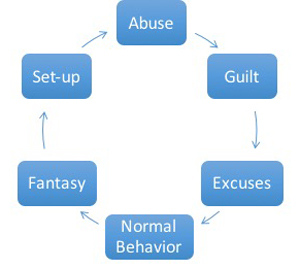How to Get Out of an Abusive Relationship
Tips for protecting yourself before and after you leave

Are you or someone you care about in an abusive relationship? Here’s how to recognize the signs of domestic abuse—physical, emotional, sexual, verbal, or financial—and get help.

When people think of domestic abuse, they often focus on domestic violence. But domestic abuse includes any attempt by one person in a marriage or intimate relationship to dominate and control the other. Domestic violence and abuse are used for one purpose and one purpose only: to gain and maintain total control over you. An abuser doesn’t “play fair.” An abuser uses fear, guilt, shame, and intimidation to wear you down and keep you under their thumb.
Domestic violence and abuse can happen to anyone; it does not discriminate. Abuse happens within heterosexual relationships and in same-sex partnerships. It occurs within all age ranges, ethnic backgrounds, and economic levels. And while women are more often victimized, men also experience abuse—especially verbal and emotional. The bottom line is that abusive behavior is never acceptable, whether from a man, woman, teenager, or an older adult. You deserve to feel valued, respected, and safe.
[Read: Help for Men who are Being Abused]
Domestic abuse often escalates from threats and verbal assault to violence. And while physical injury may pose the most obvious danger, the emotional and psychological consequences of domestic abuse are also severe. Emotionally abusive relationships can destroy your self-worth, lead to anxiety and depression, and make you feel helpless and alone. No one should have to endure this kind of pain—and your first step to breaking free is recognizing that your relationship is abusive.
BetterHelp is an online therapy service that matches you to licensed, accredited therapists who can help with depression, anxiety, relationships, and more. Take the assessment and get matched with a therapist in as little as 48 hours.
Take Assessment HelpGuide is user supported. We earn a commission if you sign up for BetterHelp’s services after clicking through from this site. Learn moreThere are many signs of an abusive relationship, and a fear of your partner is the most telling. If you feel like you have to walk on eggshells around them—constantly watching what you say and do in order to avoid a blow-up—chances are your relationship is unhealthy and abusive.
Other signs include a partner who belittles you or tries to control you, and having feelings of self-loathing, helplessness, and desperation.
To determine whether your relationship is abusive, answer the questions below. The more “yes” answers, the more likely it is that you’re in an abusive relationship.
| Are you in an abusive relationship? |
| Your inner thoughts and feelings |
|
Do you:
|
| Your partner’s belittling behavior |
|
Does your partner:
|
| Your partner’s violent behavior or threats |
|
Does your partner:
|
| Your partner’s controlling behavior |
|
Does your partner:
|
Physical abuse occurs when physical force is used against you in a way that injures or endangers you. Physical assault or battering is a crime, whether it occurs inside or outside of a family. The police have the power and authority to protect you from a physical attack.
Any situation in which you are forced to participate in unwanted, unsafe, or degrading sexual activity is sexual abuse. Forced sex, even by a spouse or intimate partner with whom you also have consensual sex, is an act of aggression and domestic violence. Furthermore, people whose partners abuse them physically and sexually are at a higher risk of being seriously injured or killed.
[Read: Recovering from Rape and Sexual Trauma]
The incidents of physical abuse seem minor when compared to those you have read about, seen on television, or heard other people talk about. There isn’t a “better” or “worse” form of physical abuse; severe injuries can result from being pushed, for example.
The incidents of physical abuse have only occurred one or two times in the relationship. Studies indicate that if your partner has injured you once, it is likely that they’ll continue to assault you.
The physical assaults stopped when you became passive and gave up your right to express yourself as you desire, to move about freely and see others, or to make decisions. It is not a victory if you have to give up your rights as a person and a partner in exchange for ending the assault!
Physical violence has not occurred. Many people are emotionally and verbally assaulted. This can be just as frightening and is often more confusing to try to understand.
Not all abusive relationships involve physical violence. Just because you’re not battered and bruised doesn’t mean you’re not being abused. Many men and women suffer from emotional abuse, which is no less destructive. Unfortunately, emotional abuse is often minimized or overlooked—even by the person experiencing it.
The aim of emotional abuse is to chip away at your feelings of self-worth and independence—leaving you feeling that there’s no way out of the relationship, or that without your abusive partner, you have nothing.
Emotional abuse includes verbal abuse such as yelling, name-calling, blaming, and shaming. Isolation, intimidation, and controlling behavior are also forms of emotional abuse.
Abusers who use emotional or psychological abuse often throw in threats of physical violence or other repercussions if you don’t do as they want.
The scars of emotional abuse are very real and they run deep. You may think that physical abuse is far worse than emotional abuse, since physical violence can send you to the hospital and leave you with physical wounds. But emotional abuse can be just as damaging—sometimes even more so.
[Read: Emotional and Psychological Trauma]
Remember, an abuser’s goal is to control you, and they will frequently use money to do so. Economic or financial abuse includes:
Despite what many people believe, domestic violence and abuse does not take place because an abuser loses control over their behavior. In fact, abusive behavior and violence is a deliberate choice to gain control. Perpetrators use a variety of tactics to manipulate you and exert their power, including:
Dominance. Abusive individuals need to feel in charge of the relationship. They may make decisions for you and the family, tell you what to do, and expect you to obey without question. Your abuser may treat you like a servant, child, or even as their possession.
Humiliation. An abuser will do everything they can to lower your self-esteem or make you feel defective in some way. After all, if you believe you’re worthless and that no one else will want you, you’re less likely to leave. Insults, name-calling, shaming, and public put-downs are all weapons of abuse designed to erode your self-worth and make you feel powerless.
Isolation. In order to increase your dependence on them, an abusive partner will cut you off from the outside world. They may keep you from seeing family or friends, or even prevent you from going to work or school. You may have to ask permission to do anything, go anywhere, or see anyone.
Threats. Abusers commonly use threats to keep their partners from leaving or scare them into dropping charges. Your abuser may threaten to hurt or kill you, your children, other family members, or even pets. They may also threaten to commit suicide, file false charges against you, or report you to child services.
Intimidation. Your abuser may use a variety of intimidation tactics designed to scare you into submission. Such tactics include making threatening looks or gestures, smashing things in front of you, destroying property, hurting your pets, or putting weapons on display. The message behind these actions is that violent consequences will follow if you don’t obey.
Denial and blame. Abusers are adept at making excuses for the inexcusable. They may blame their abusive and violent behavior on a bad childhood, a bad day, or even on you and the kids, the victims of their abuse. They may minimize the abuse or deny that it occurred. Often, they will shift the responsibility on to you: somehow, their violent and abusive behavior is your fault.
Abusers pick and choose whom to abuse. They don’t insult, threaten, or assault everyone in their life who gives them grief. Usually, they save their abuse for the people closest to them, the ones they claim to love.
Abusers carefully choose when and where to abuse. They control themselves until no one else is around to witness their behavior. They may act like everything is fine in public, but then lash out instantly as soon as you’re alone with them.
Abusers are able to stop their abusive behavior when it benefits them. Most abusers are not out of control. In fact, they’re able to immediately stop their abusive behavior when it’s to their advantage to do so (for example, when the police show up or their boss calls).
Violent abusers usually direct their blows where they won’t show. Rather than acting out in a mindless rage, many physically violent abusers carefully aim their kicks and punches where the bruises and marks won’t show.
Domestic abuse falls into a common pattern or cycle of violence:

Abuse – Your abusive partner lashes out with aggressive, belittling, or violent behavior. This treatment is a power play designed to show you “who is boss.”
Guilt – Your partner feels guilt after abusing you, but not because of their actions. They’re more worried about the possibility of being caught and facing consequences for their abusive behavior.
Excuses – Your abuser rationalizes what they have done. The person may come up with a string of excuses or blame you for provoking them—anything to avoid taking responsibility.
“Normal” behavior – Your partner does everything in their power to regain control and ensure that you’ll stay in the relationship. A perpetrator may act as if nothing has happened, or they might “turn on the charm.” This peaceful honeymoon phase may give you hope that the abuser has really changed this time.
Fantasy and planning – Your abuser begins to fantasize about repeating the abuse. They spend a lot of time thinking about what you’ve done wrong and how they’ll make you pay for it. Then they form a plan for turning the fantasy of abuse into reality.
Set-up – Your abuser sets you up and puts their plan in motion, creating a situation where they can justify abusing you.
Your abuser’s apologies and loving gestures in between the episodes of abuse can make it difficult to leave. They may cause you to believe that you are the only person who can help them, that they will change their behavior, and that they truly love you. However, the dangers of staying are very real.
A man abuses his partner. After he hits her, he experiences self-directed guilt. He says, “I’m sorry for hurting you.” What he does not say is, “Because I might get caught.”
He then rationalizes his behavior by accusing his partner of having an affair. He tells her, “If you weren’t such a worthless whore, I wouldn’t have to hit you.”
He then acts contrite, reassuring her that it will not happen again.
But later he fantasizes and reflects on past abuse and decides to hurt her again.
He plans on sending her to the grocery store, purposely choosing a busy time. She is then held up in traffic and returns a few minutes later than expected. In his mind, he justifies assaulting her by blaming her for having an affair with the store clerk. He has just set her up.
It’s impossible to know with certainty what goes on behind closed doors, but there are some telltale signs of emotional abuse and domestic violence. If you witness these warning signs of abuse in a friend, family member, or co-worker, take them very seriously.
People who are being abused may:
People who are being physically abused may:
People who are being isolated by their abuser may:
People who are being abused may:
If you suspect that someone you know is being abused, speak up! If you’re hesitating—telling yourself that it’s none of your business, you might be wrong, or that the person might not want to talk about it—keep in mind that expressing your concern will let the person know that you care and may even save their life.
Talk to the person in private and let them know that you’re concerned. Point out the signs you’ve noticed that worry you. Tell the person that you’re there for them, whenever they feel ready to talk. Reassure them that you’ll keep whatever is said between the two of you, and let them know that you’ll help in any way you can.
[Read: How to Get Out of an Abusive Relationship]
Remember, abusers are very good at controlling and manipulating their victims. People who have been emotionally or physically abused are often depressed, drained, scared, ashamed, and confused. They need help getting out of the situation, yet their partner has often isolated them from their family and friends.
By picking up on the warning signs and offering support, you can help someone escape an abusive situation and begin healing.
| Do: | Don’t: |
|---|---|
| Ask if something is wrong | Wait for the person to come to you |
| Express your concern | Blame or judge them |
| Listen and validate | Pressure them to act |
| Offer to help | Give advice |
| Support their decisions | Place conditions on your support |
Call the National Domestic Violence Hotline at 1-800-799-7233 (SAFE).
Visit ShelterSafe to find the helpline of a women’s shelter near you.
Call Women’s Aid UK at 0808 2000 247.
Call Women’s Aid at 1800 341 900.
Call 1800RESPECT at 1800 737 732.
Call the National Domestic Violence Hotline at 1-800-799-7233.
Call the ManKind Initiative at 01823 334244.
Call AMEN at 046 902 3710.
Visit One in Three Campaign.
Millions of readers rely on HelpGuide.org for free, evidence-based resources to understand and navigate mental health challenges. Please donate today to help us save, support, and change lives.
Donate to HelpGuide.org today